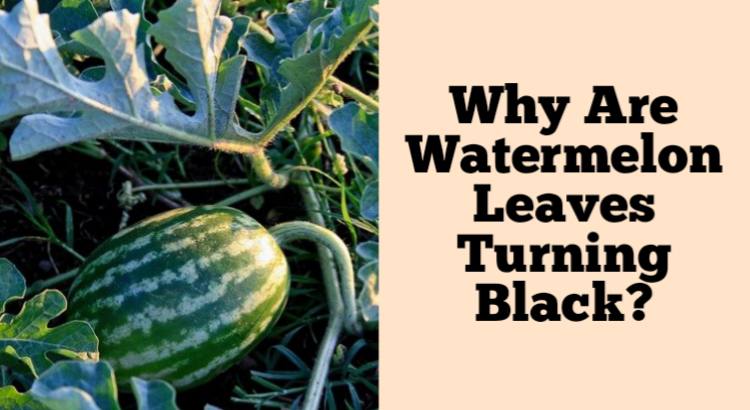Watermelon leaves turning black can be a sign of disease or nutrient deficiency. Fortunately, the problems can be identified and treat your plants so they stay healthy and productive.
Watermelons thrive in warm weather, so if temperatures drop below 50 degrees Fahrenheit when the plant is young, you may see blackened leaves. If this happens, your seedling may not recover and will die. You can try growing watermelons indoors then transplant the seedlings once the weather becomes fine.
If you water with a hose or watering can that hasn’t been cleaned in a while, or use water high in mineral content, you could be damaging your watermelon plants’ leaves.
Watermelons are sensitive to minerals in the water and can get black spots on their leaves. The best way to avoid this is by making sure your tools are clean before you use them for watering.
You can clean them with detergent and warm water if they need it; just make sure you rinse them well after so any residue doesn’t come into contact with your plants.
You may also want to consider using distilled water on your plants if they’re particularly sensitive—distilled has no minerals in it, which means less damage to their leaves!
Bacterial leaf spot is another issue that causes dark spots and damaged leaves.
You may also notice that the tips of the leaves and stems turn black. This is a common symptom of bacterial leaf spot.
The disease causes dark spots on leaves, which can eventually spread across the entire leaf surface.
As the disease progresses, yellowing and browning will occur on both sides of the leaf. Fruit with this type of infection will rot quickly after harvest due to its poor quality and lack of marketability (unable to be sold).
The only way to treat this disease is with copper-based fungicides; unfortunately, you will not be able to utilize these until after harvest as they are toxic if used during growth stages when watermelons are sensitive to chemicals like copper products
In dry climates or when rainfall is low, powdery mildew can attack your watermelons and cause their leaves to turn white and then eventually black.
Powdery mildew can be prevented by spraying the plant with a fungicide before the disease appears in order to keep it from spreading.
If you have already been affected by powdery mildew on your watermelon plants, treat them with a fungicide as soon as possible for best results.
If you do not want to use chemical treatments for this problem, there are other options for treating powdery mildew naturally:
Spray baking soda on the affected area of plants once per week until signs of infection disappear (this method works best in greenhouses)
Spray hydrogen peroxide on fungal growths once a week until they disappear
Phytophthora blight is a disease caused by fungi that can cause blackened leaves as well as sunken areas on watermelons’ skin.
Phytophthora blight is common in warm, humid climates. The pathogen enters plant tissue through wounds or natural openings such as stomates (breathing pores) on the leaf surface.
Once inside the watermelon, the fungus will spread from leaf to root and eventually kill the entire plant if left untreated.
There are a few different possibilities for why your plants are turning black.
The first is bacterial leaf spot, which causes small brown spots on the leaves. This disease is caused by the bacterium Xanthomonas campestris pv. vesicatoria and can be treated with copper compounds or Bordeaux mixture—spraying it directly onto the foliage once every seven days.
Bacterial speck also causes small brown spots on watermelon leaves, but this disease doesn’t spread as fast as bacterial leaf spot does, so spraying regularly should prevent further infections from occurring until warmer weather arrives again in spring.
Powdery mildew is another fungal disease that can affect your plants during cooler temperatures when humidity levels are high; fortunately it’s easy to treat by spraying them with neem oil or baking soda solution (1 tablespoon baking soda diluted in 1 gallon of water).
If you notice bleached-looking patches of green on both sides of each leaf then you likely have phytophthora blight—this fungus thrives in wet conditions so try not overwatering your plants during periods of rain if possible!
Black Spots On Watermelon Leaves
Watermelon leaves are susceptible to several pests and diseases, including leaf spot. The black spots on watermelon leaves caused by the fungus Cercospora spp. are small, circular brown spots that eventually turn yellow or tan.
These spots usually appear on the upper surface of the leaf, but they can also appear on the underside of leaves.
The fungus that causes leaf spot thrives in warm, humid weather and attacks plants when they are under stress.
Watermelons are prone to the disease when the plants have been stressed by too much heat or moisture during fruit development. High temperatures and lack of air circulation also contribute to leaf spot problems.
Watermelons are very sensitive to leaf diseases and will show symptoms within two weeks if infected by pathogens.
Conclusion
Sometimes, the leaves of your watermelon plant will turn black. This is usually not cause for alarm, as it can be easily remedied.
However, if the black spots on your leaf edges seem to be spreading and increasing in number, then you may need to prune some of your watermelon plants’ leaves off at ground level in order to prevent further spread of this problem.

